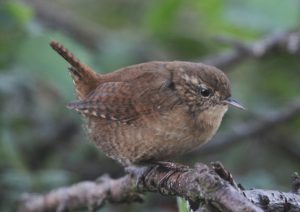 Where can we see the commonest and most widespread bird in Britain? To many people this will mean the puffin that breeds in huge colonies on some islands whilst others will perhaps think of starlings with their famous huge roosts. In fact the answer is much closer to home as it is a common bird in gardens as well as elsewhere – the wren. It is one of the smallest and most enigmatic of birds and even its name is unusual. The wren is just about the shortest of name of any bird yet, in contrast, its Latin name is one of the longest as it is “Troglodytes” and as far size it is smaller in length than the blue tit. The wren weighs, on average, about eight gms which is less than the weight of a pound coin! As for sheer numbers there are estimated to be 8.5 million pairs in the UK of which there are 1.5 million pairs in Scotland. There are another 2.5 million in Ireland. The wren is also unusual in that it has five races in Scotland of which the most famous is the St. Kilda wren. These are races of birds that have been isolated for so long they have developed characteristics of their own. For example, the St. Kilda wren is much larger than their mainland counterpart and has a much louder song. On St. Kilda they nest in the walls and the small stone built structures called cleatean. On my many visits to St. Kilda it was always a thrill to see and hear one singing and it seemed to me it had to be loud to compete with the crashing waves on the shoreline.
Where can we see the commonest and most widespread bird in Britain? To many people this will mean the puffin that breeds in huge colonies on some islands whilst others will perhaps think of starlings with their famous huge roosts. In fact the answer is much closer to home as it is a common bird in gardens as well as elsewhere – the wren. It is one of the smallest and most enigmatic of birds and even its name is unusual. The wren is just about the shortest of name of any bird yet, in contrast, its Latin name is one of the longest as it is “Troglodytes” and as far size it is smaller in length than the blue tit. The wren weighs, on average, about eight gms which is less than the weight of a pound coin! As for sheer numbers there are estimated to be 8.5 million pairs in the UK of which there are 1.5 million pairs in Scotland. There are another 2.5 million in Ireland. The wren is also unusual in that it has five races in Scotland of which the most famous is the St. Kilda wren. These are races of birds that have been isolated for so long they have developed characteristics of their own. For example, the St. Kilda wren is much larger than their mainland counterpart and has a much louder song. On St. Kilda they nest in the walls and the small stone built structures called cleatean. On my many visits to St. Kilda it was always a thrill to see and hear one singing and it seemed to me it had to be loud to compete with the crashing waves on the shoreline.
Wrens commonly nest in gardens but also in a very wide range of other habitats from islands to mature woodland and hedgerows. One unusual habit is when they are nest building because the male alone builds five to eight nests that are situated in hollows, crevices or holes in banks or walls. It is a very unusual structure as it is round with an entrance hole in the side. Once all these male nests are built the female comes along and chooses one which she lines with feathers and other material. She then lays 5 or 6 eggs which she alone incubates. Both male and female feed the young chicks and they both feed them for a few days after they have fledged and left the nest. They often have two broods each summer with the breeding starting in April. In ideal habitats such as woodland and large mature gardens a male will often have two females raising two broods at the same time. Another usual habit is that they will flock together to roost. In one large nest box 63 wrens were recording entering at dusk one evening whilst nearly 100 were recorded going to roost in an attic.
The song of the wren, or at least the loud trill, is heard right through the year and is often what gives the bird away as they can be very secretive, even in gardens. Troglodytes is Greek meaning “one who creeps into holes”. There are many Scots names such as wrannock, jenny wren and our Lady’s hen. The name Lady’s hen comes from the legend that the wren brought moss to cover the infant Jesus in the stable. Many names are from small children such as Kitty or Jenny. One Gaelic name is “Dreathan-donn” meaning brown wren.
The wren was portrayed on the obverse side of the farthing coin which ceased to be legal tender in January 1961.
Tags: highland birds
